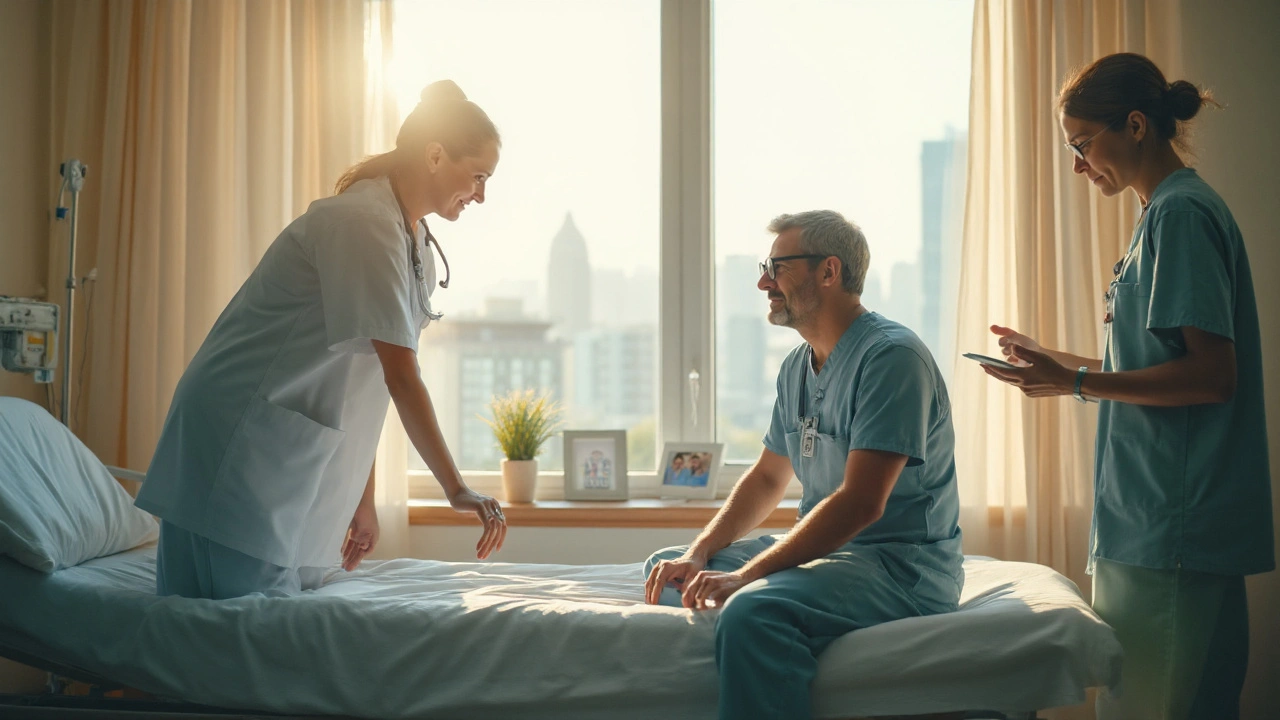Living Through Organ Rejection: A Patient’s View of Transplant Challenges

Organ rejection is a dangerous immune response where the recipient’s body attacks the transplanted organ, typically occurring weeks to years after surgery. It shapes every post‑transplant decision, from medication adjustments to lifestyle changes. Understanding rejection through a patient’s eyes reveals the day‑to‑day reality of biopsies, medication side‑effects, and the relentless hope that fuels recovery.
Why Rejection Happens: The Immunology Behind the Scene
When a donor organ lands in a new body, the immune system immediately spots foreign proteins called human leukocyte antigens (HLA). HLA matching is a process that compares donor and recipient antigen profiles to lower the risk of rejection. Even with a perfect match, the body’s default defense is to recognize any mismatch as a threat.
The first line of defense is immunosuppression-a cocktail of drugs that dial down immune activity. Common agents include tacrolimus, mycophenolate, and low‑dose steroids. While lifesaving, these drugs also blur the line between protection and vulnerability, making infections a constant worry.
Types of Rejection You’ll Encounter
Rejection isn’t a single event; it comes in flavors that differ in timing, symptoms, and treatment. Below is a quick snapshot:
| Attribute | Acute Rejection | Chronic Rejection |
|---|---|---|
| Onset | Days to months post‑transplant | Months to years post‑transplant |
| Typical Symptoms | Fever, pain, organ dysfunction | Gradual loss of function, fibrosis |
| Primary Treatment | High‑dose steroids, IV antibodies | Optimizing immunosuppression, possible re‑transplant |
| Biopsy Findings | Inflammatory infiltrates | Vascular thickening, scar tissue |
| Prognosis | Reversible if caught early | Progressive, may lead to organ loss |
Both types share the need for vigilant monitoring, but the strategies diverge. Acute episodes often respond to a quick steroid pulse, while chronic changes demand a long‑term plan.
Monitoring: The Role of Biopsy and Blood Tests
Imagine going for a routine check‑up and being told you need a needle in your abdomen. That’s biopsy-the gold standard for confirming rejection. A small tissue sample is examined under a microscope for tell‑tale immune cells.
Blood work is the quieter sibling. Levels of creatinine (for kidney) or liver enzymes can hint at trouble, while drug levels of tacrolimus or cyclosporine must stay within a narrow therapeutic window.
Patients often describe the anxiety of “waiting for results”. My own waiting period felt like a roller coaster: each lab call could mean a dose change, a new clinic visit, or a sudden rush to the transplant center.
Living with Immunosuppressive Drugs
Let’s talk about tacrolimus-the backbone of most regimens. Therapeutic levels hover between 5-15ng/mL, yet the drug can cause tremors, gum overgrowth, and kidney strain. Adjusting the dose feels like tuning a piano; too low = rejection, too high = toxicity.
Mycophenolate adds another layer: it curbs lymphocyte proliferation but often leads to diarrhea and a higher infection risk. Steroids are the classic backup, yet long‑term use brings weight gain, bone thinning, and mood swings.
Balancing these side‑effects is a daily negotiation with the transplant team. Many patients keep a diary, noting everything from medication times to “odd” sensations. This habit can catch early signs of rejection or drug toxicity before labs do.

The Emotional Landscape: Hope, Fear, and Community
Medical facts are only half the story. The psychological impact of facing organ rejection can be intense. Fear of losing the graft often coexists with gratitude for a second chance at life.
Support groups-both in‑person and online-provide a lifeline. Connecting with someone who’s just survived an acute episode can turn abstract medical jargon into a relatable narrative. I found a New Zealand transplant forum where members shared tips on managing steroid‑induced insomnia; the collective wisdom saved me weeks of trial‑and‑error.
Family dynamics shift, too. Partners become medication managers, children learn to respect hospital appointments, and friends adjust social plans around clinic days. Open communication prevents misunderstandings and keeps the whole support network aligned.
When Rejection Isn’t Reversible: Re‑transplantation and End‑of‑Life Choices
Unfortunately, some rejections become irreversible. Chronic rejection in a kidney may progress to end‑stage renal disease, necessitating dialysis while awaiting another donor. The decision to list for a re‑transplant is fraught with ethical and emotional weight.
Allocation systems-like the United Network for Organ Sharing (UNOS) in the U.S. or the New Zealand Organ Allocation System-prioritize patients based on medical urgency, waiting time, and compatibility. Understanding this framework empowers patients to advocate effectively during transplant center meetings.
If a re‑transplant isn’t feasible, palliative care becomes a partner rather than a fallback. Focusing on quality of life, managing pain, and preserving dignity are core goals. Many patients find peace in legacy projects-writing memoirs, mentoring newer transplant recipients, or volunteering with organ donation campaigns.
Practical Checklist for Patients Facing Rejection
- Track medication doses, blood levels, and side‑effects daily.
- Schedule routine labs and biopsies; note any new symptoms immediately.
- Maintain open lines with your transplant coordinator-ask about any lab result that seems off.
- Join a patient support group; share both successes and setbacks.
- Plan for emergencies: keep a list of meds, allergies, and your transplant center’s contact info.
Looking Ahead: Innovations That May Change the Rejection Narrative
Researchers are testing tolerance‑inducing protocols, like donor‑specific regulatory T‑cell infusions, that could eventually reduce or eliminate lifelong immunosuppression. Gene‑editing tools aim to create “universal” organs with minimal HLA expression, potentially sidestepping rejection altogether.
While these breakthroughs are promising, they remain years away from routine practice. Until then, the patient‑centered approach-education, vigilant monitoring, and emotional support-remains the most effective shield against rejection.

Frequently Asked Questions
What are the early signs of acute organ rejection?
Early signs vary by organ but often include sudden pain at the transplant site, fever, flu‑like symptoms, and a rapid rise in specific blood markers (e.g., creatinine for kidney, liver enzymes for liver). Prompt medical evaluation is crucial.
How often do transplant recipients need biopsies?
The schedule differs by organ and center. Many protocols call for a monitoring biopsy at 1, 3, and 6 months post‑transplant, then annually or whenever lab values suggest trouble.
Can lifestyle changes reduce the risk of rejection?
Yes. Maintaining a balanced diet, regular moderate exercise, avoiding smoking, and adhering to medication schedules can strengthen overall health and lower inflammatory triggers that might provoke rejection.
What should I do if I miss a dose of my immunosuppressive drug?
Contact your transplant coordinator immediately. Usually, you’ll be instructed to take the missed dose as soon as you remember if it’s within a few hours; otherwise, skip it and resume the regular schedule to avoid double‑dosing.
Is it possible to live a normal life after a transplant?
Many recipients return to work, travel, and enjoy hobbies, especially after the first year when rejection risk stabilizes. Ongoing medical care remains essential, but a fulfilling life is absolutely achievable.
Kevin Estrada
September 24, 2025 AT 04:26okay but like… have y’all ever tried taking tacrolimus and then tried to hold a conversation without your hands shaking like a caffeine-addicted squirrel? i once spilled my coffee on my cat and she looked at me like i was the problem. also, my gums? they’re basically a coral reef now. transplant life: where your body betrays you but your dentist gets a promotion.
Katey Korzenietz
September 24, 2025 AT 04:31Ugh. I can't believe people still think 'lifestyle changes' are enough. No. Just no. If you're not on the exact right combo of immunosuppressants, you're playing Russian roulette with your new kidney. I saw a guy on Reddit say he 'ate clean' and it 'fixed' his rejection-BRO. That's not medicine, that's delusion. Get your numbers checked. Stop Googling.
Ethan McIvor
September 25, 2025 AT 16:01It’s funny how we talk about rejection like it’s just a medical event… but it’s really the body screaming, ‘I didn’t sign up for this.’
Every time I get a lab result, I feel like I’m waiting for a breakup text. ‘It’s not you, it’s me’-except it’s my immune system breaking up with my new liver.
And yet… somehow, we keep showing up. For the biopsies. For the pills. For the fear. Maybe that’s the real miracle-not the organ, but the stubborn, messy hope we carry.
:-)
Mindy Bilotta
September 25, 2025 AT 21:00For anyone new to this: keep a meds log. I used a simple Google Sheet with columns for time, dose, side effects, and mood. One day I noticed my tremors spiked every time I ate avocado. Turned out it was interacting with tacrolimus-my nurse had never heard of that, but the data saved me from a hospital trip.
Also, support groups are gold. I cried in one and someone sent me homemade ginger tea. That’s the stuff no drug can give you.
And yes, you can travel. I went to Banff last year. Took my meds in a pill organizer. Didn’t die. You won’t either.
Michael Bene
September 26, 2025 AT 20:06Let’s be real-this whole transplant system is a glorified lottery with extra steps. You get a new organ, sure, but you also get a lifetime subscription to Side Effect Roulette™. Tacrolimus makes you look like a zombie who lost a fight with a toaster. Mycophenolate turns your gut into a haunted house. Steroids? Congrats, you now have the face of a balloon animal.
And don’t even get me started on the biopsy. They stick a needle in your kidney like it’s a piñata and we’re all waiting for the candy. Meanwhile, you’re Googling ‘can you die from a biopsy’ at 3 a.m.
But hey-at least we’re alive. And weirdly, that’s the only thing that matters. The rest? Just the price of admission to the weird, beautiful, terrifying club of second chances.